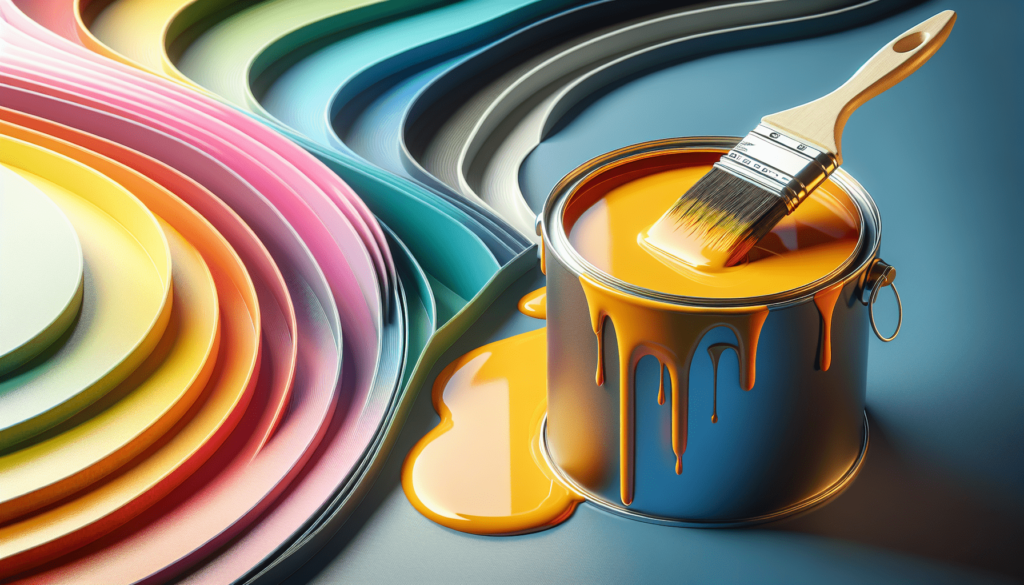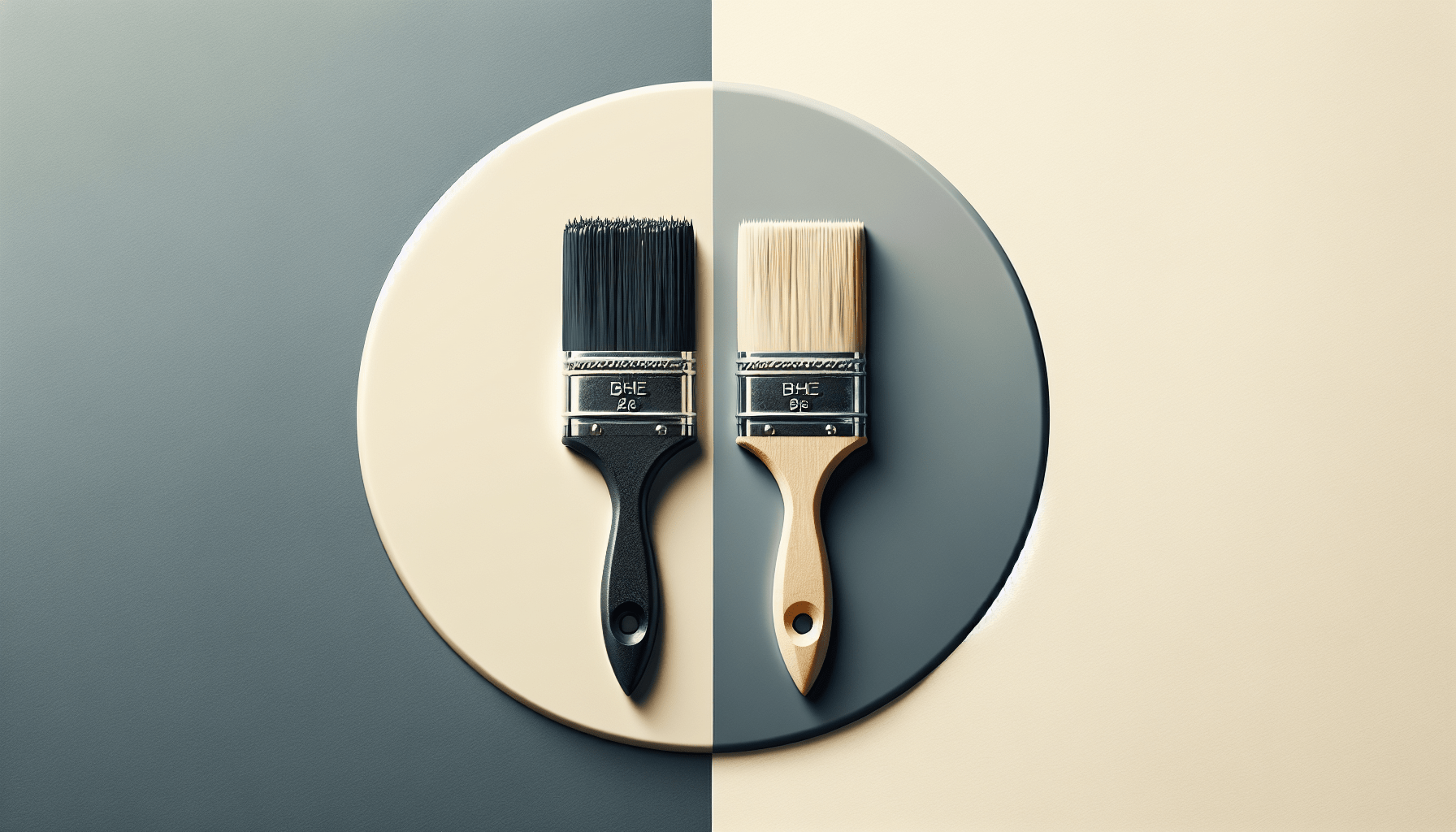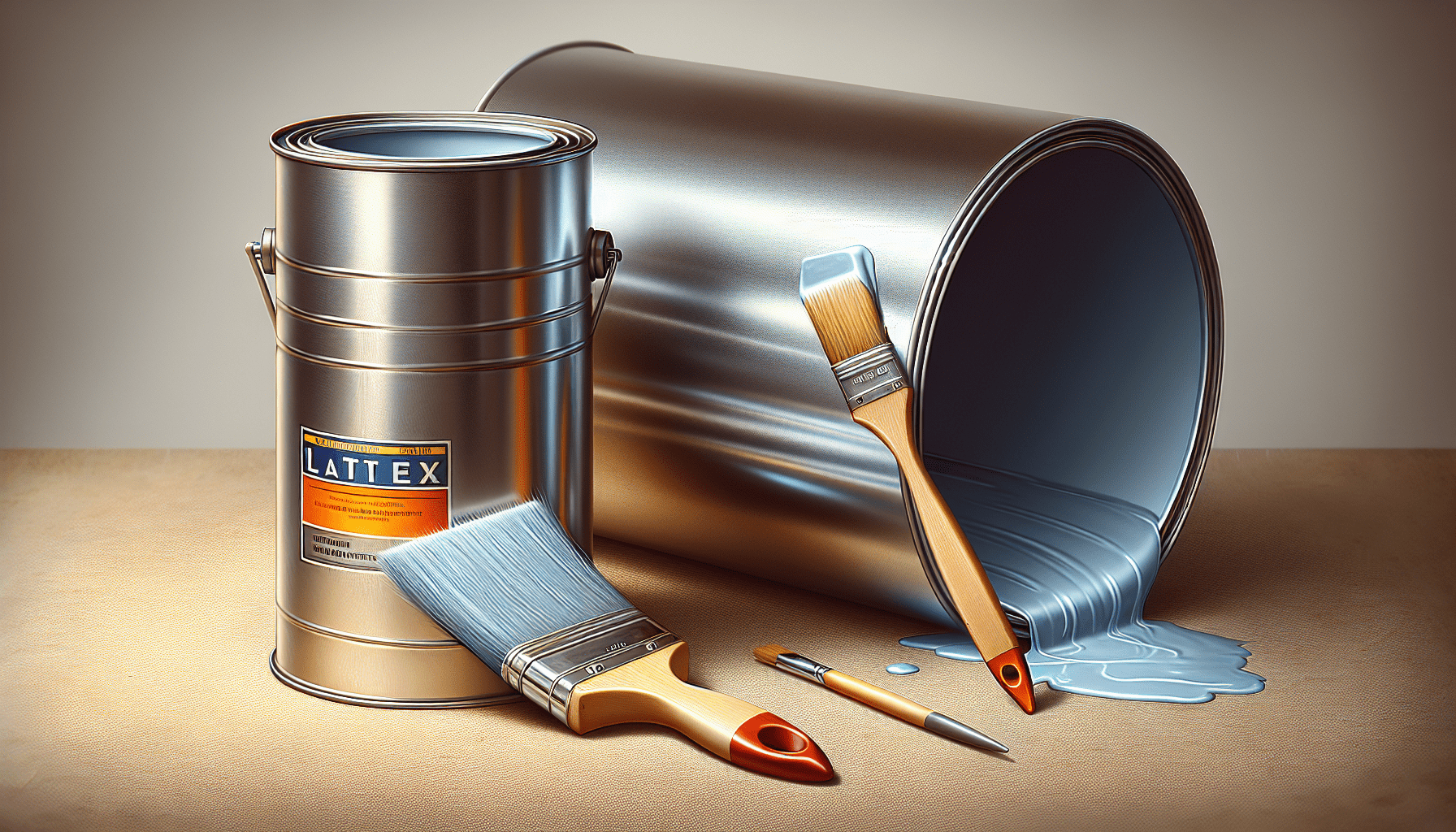Benjamin Moore Paint is widely known for its exceptional quality and wide range of color options. However, there is a question that often arises among consumers: is Benjamin Moore Paint latex? In this article, we will explore the composition of Benjamin Moore Paint and delve into whether or not it contains latex. By examining its ingredients and exploring its performance characteristics, we will provide you with a clear understanding of what you can expect from this renowned paint brand.

What is Latex Paint?
Definition
Latex paint, also known as acrylic latex paint, is a type of water-based paint that contains synthetic polymers as its main ingredient. It is named “latex” because the initial latex paints used natural latex from rubber trees as a binder. However, modern latex paints now utilize synthetic binders to ensure superior performance and durability.
Composition
Latex paint is typically composed of four main components: pigment, binder, solvent, and additives. The pigment provides color and opacity to the paint, while the binder holds the pigment particles together and helps the paint adhere to surfaces. Solvents are present in the paint to facilitate its application and then evaporate as the paint dries. Additives are included to enhance various properties like flow, leveling, and durability.
Advantages
There are several advantages to using latex paint. Firstly, it is easy to clean up since it can be diluted and cleaned off with soap and water, eliminating the need for harsh solvents. Additionally, latex paint has low odor compared to oil-based paints, making it more suitable for indoor use where ventilation may be limited. Furthermore, latex paint dries relatively quickly, allowing for faster completion of painting projects. Lastly, latex paint is UV resistant, which helps prevent color fading and degradation over time.
Disadvantages
Despite its many advantages, latex paint does have a few disadvantages. One drawback is that it is not as durable as oil-based paints, especially when it comes to high-traffic areas or exterior surfaces exposed to harsh weather conditions. Another potential downside is that latex paint may not adhere well to certain surfaces that have been previously painted with oil-based paints. In such cases, proper surface preparation, including priming, may be necessary to ensure adhesion. Lastly, some individuals may experience allergies or sensitivities to the chemicals present in latex paint, so it is important to take appropriate safety precautions.
Types of Benjamin Moore Paint
Regal Select Latex Paint
Regal Select is a premium latex paint offered by Benjamin Moore. It is renowned for its outstanding coverage, smooth finish, and excellent durability. This paint is available in a wide range of colors, ensuring there is a shade to suit every preference and style. The Regal Select line also includes a variety of finishes, such as matte, eggshell, satin, semi-gloss, and high-gloss, providing versatility for different surfaces and applications.
Aura Exterior Paint
Aura Exterior is a top-of-the-line latex paint specifically designed for use on exterior surfaces. It boasts exceptional fade resistance, color retention, and protection against weathering, ensuring a long-lasting and beautiful finish. The Aura Exterior paint line offers a wide spectrum of colors and finishes, enabling homeowners to achieve their desired aesthetics while effectively protecting their homes from the elements.
Advance Interior Paint
Advance Interior is a latex paint that provides the smooth and durable finish of an oil-based paint while still being water-based. This unique formulation allows for easy application and cleanup while delivering a high-quality, durable result. Advance Interior paint is ideal for use on cabinets, furniture, and other interior surfaces that require superior adhesion, durability, and a refined appearance.
Features of Benjamin Moore Latex Paint
Durable Finish
One of the standout features of Benjamin Moore latex paint is its ability to create a durable finish that can withstand regular wear and tear. The paint’s composition and formulation contribute to its resistance against chipping, cracking, and peeling, ensuring that your painted surfaces maintain their vibrant appearance even in high-traffic areas.
Low Odor
Benjamin Moore latex paint is formulated with low levels of volatile organic compounds (VOCs), resulting in a paint with minimal odor. This feature makes it suitable for use in indoor spaces where strong smells may be unpleasant or pose potential health risks. The low odor allows for a more comfortable and enjoyable painting experience, especially for those with sensitivities to strong chemical smells.
Quick Drying
One of the advantages of latex paint is its relatively quick drying time compared to oil-based paints. Benjamin Moore latex paint is designed to dry quickly, allowing for faster recoating or completion of painting projects. This feature comes in handy when time is a constraint or when multiple coats are required. The quick drying time facilitates efficient workflow and reduces the overall time needed to achieve the desired painted finish.
Easy Clean-up
Unlike oil-based paints, which require solvents for cleanup, Benjamin Moore latex paint can be easily cleaned up with just soap and water. This makes the cleanup process hassle-free and environmentally friendly. By eliminating the need for harsh solvents, latex paint simplifies post-painting cleanup and reduces potential risks associated with handling and disposing of chemical cleaners.
Application of Benjamin Moore Latex Paint
Interior Walls
Benjamin Moore latex paint is well-suited for painting interior walls. Its versatility allows for smooth application on a variety of surfaces, including drywall, plaster, and wood. Whether you are refreshing the look of your living room or adding a splash of color to your bedroom, Benjamin Moore latex paint provides excellent coverage and an even finish, enhancing the overall aesthetics of your space.
Exterior Surfaces
For exterior applications, Benjamin Moore latex paint, such as Aura Exterior, is the ideal choice. Its superior durability and resistance to fading and weathering make it perfectly suited for protecting and beautifying various exterior surfaces, such as siding, trim, and doors. With its extensive color range and range of finishes, Benjamin Moore latex paint allows homeowners to achieve the desired look and maintain the integrity of their home’s exterior.
Trim and Doors
When it comes to painting trim and doors, Benjamin Moore latex paint delivers exceptional results. Its ability to adhere well to different surfaces, combined with its durability, helps ensure that the trim and doors look pristine and resist normal wear and tear. Benjamin Moore offers latex paints that specifically cater to the needs of trim and doors, providing superior adhesion, smooth coverage, and a lasting finish.
Ceilings
Painting ceilings can be a challenging task, but Benjamin Moore latex paint makes it easier. Whether you are painting a high ceiling or a intricate textured surface, Benjamin Moore latex paint provides excellent coverage and hides imperfections. Its quick drying time and low odor also contribute to a more efficient and pleasant painting experience when tackling ceilings.

Preparation for Painting with Benjamin Moore Latex Paint
Surface Cleaning
Before painting with Benjamin Moore latex paint, it is crucial to clean the surface thoroughly. Remove any dirt, grease, dust, or loose particles by washing the surface with soap and water. For especially dirty or greasy surfaces, it may be necessary to use a mild detergent or cleaner. Ensure the surface is completely dry before proceeding with painting.
Priming
While Benjamin Moore latex paints often have excellent adhesion properties, certain surfaces may benefit from priming before painting. Porous surfaces, new or repaired drywall, or surfaces previously painted with dark colors may require a primer to ensure proper adhesion and color uniformity. Priming helps the paint bond effectively and promotes better overall paint performance and longevity.
Tape and Covering
To protect surfaces that you do not want to paint, such as trim, windows, or floors, it is important to use painter’s tape and suitable covering materials. Apply painter’s tape along the edges of surfaces you want to protect, ensuring a clean and crisp paint line. Cover floors, furniture, and other adjacent areas with drop cloths or plastic sheeting to prevent accidental spills or splatters.
Choosing the Right Tools
Using the appropriate tools is essential for achieving a professional finish when painting with Benjamin Moore latex paint. Choose high-quality brushes or rollers that are specifically designed for latex paint to ensure smooth application and even coverage. Consider the type of surface you are painting and the desired finish to determine the best tools for the job. Additionally, have a paint tray, paint sticks, and a variety of brushes and roller covers on hand for different areas and techniques.
Steps for Painting with Benjamin Moore Latex Paint
Color Selection
Before starting your painting project, take the time to select the perfect color or colors for your space. Benjamin Moore provides a wide range of color options, and many retailers offer color samples or larger swatches that you can test on your walls. Consider the lighting in the room, existing décor, and personal preferences when choosing the color. Once you have settled on a color, ensure you have enough paint to complete the project and mix the paint thoroughly before starting.
Cutting In
Start by cutting in the edges of the walls and other areas using a high-quality angled brush. Cutting in involves carefully painting along the trim, corners, and ceiling lines before using a roller for the larger areas. This technique ensures a neat and professional finish with crisp lines, especially when transitioning from one color to another. Take your time and work in small sections to maintain control over the paint application.
Rolling the Paint
After cutting in, use a roller applicator to cover larger areas of the wall. Start from the top corner of the wall and work your way down in a “W” or “N” pattern to evenly distribute the paint. Use a roller cover appropriate for the surface and finish you desire. Be mindful of not overloading the roller with paint, as it may lead to drips or uneven coverage. Remember to periodically reload the roller with paint as needed and maintain a consistent rolling speed and pressure to achieve an even coat.
Second Coat Application
Once the first coat of Benjamin Moore latex paint has fully dried, inspect the painted surface to determine if a second coat is necessary. In many cases, a second coat may be needed to achieve the desired color intensity and to ensure full coverage, especially if you are transitioning from a dark color to a lighter one. Apply the second coat using the same cutting-in and rolling techniques as before, ensuring proper drying time between coats.
Tips for Using Benjamin Moore Latex Paint
Stirring the Paint
Before you begin painting and periodically during the painting process, it is essential to stir the Benjamin Moore latex paint thoroughly. This ensures that any settled pigments, binders, or additives are evenly distributed throughout the paint. Use a paint stick or mixing tool to stir the paint in a circular motion, scraping the sides and bottom of the container. Properly stirred paint helps maintain consistent color and finish throughout the project.
Proper Brush Techniques
When using a brush with Benjamin Moore latex paint, proper brush techniques are crucial for achieving a smooth and professional finish. Dip the brush no more than one-third of its length into the paint and lightly tap it against the side of the paint container to remove excess paint. Apply the paint using long, smooth strokes in the direction of the surface, taking care not to apply too much pressure, which can result in streaks or brush marks.
Maintaining a Wet Edge
To avoid visible seams or overlapping marks on large surfaces, it is important to maintain a wet edge while painting with Benjamin Moore latex paint. Work in manageable sections and ensure each stroke slightly overlaps the previous one to maintain a continuous wet edge. This technique helps blend the strokes together and prevents the paint from drying too quickly, which could result in uneven application and overlapping marks.
Clean-up and Storage
After you have finished painting with Benjamin Moore latex paint, promptly clean your brushes, rollers, and any other painting tools using soap and water. Rinse them thoroughly to remove any remaining paint residue. Store the paint cans tightly sealed to prevent air exposure and possible spoilage. Label the cans with the color and date of purchase for future reference. Proper paint storage and tool maintenance will preserve the quality and extend the life of your Benjamin Moore latex paint.
Frequently Asked Questions about Benjamin Moore Latex Paint
Can it be used on all surfaces?
Benjamin Moore latex paint is versatile and can be used on a variety of surfaces, including drywall, wood, plaster, and masonry. However, it is essential to ensure that the surface is properly prepared and suitable for latex paint. Some surfaces may require priming to maximize adhesion and longevity. For specific surface and application recommendations, consult the product label or seek advice from a Benjamin Moore retailer.
Does it require a primer?
Whether a primer is required before painting with Benjamin Moore latex paint depends on the surface being painted and the desired result. Priming is recommended for porous surfaces, new drywall, or surfaces with existing stains or color variations. Using a primer promotes enhanced adhesion, color uniformity, and overall paint performance. Follow the product label instructions or consult a Benjamin Moore retailer to determine if a primer is necessary for your particular project.
How long does it take to dry?
The drying time for Benjamin Moore latex paint can vary based on factors such as temperature, humidity, and ventilation. In optimal conditions, latex paint typically dries to the touch within one to four hours. It is important to allow sufficient drying time before applying a second coat or undertaking any tasks that may damage the freshly painted surface. Refer to the product label for specific drying time recommendations.
Can it be used outdoors?
While standard latex paint may not be as durable as specialized exterior paints, Benjamin Moore offers latex paint formulations explicitly designed for exterior use, such as Aura Exterior. These paints provide superior durability, UV resistance, and protection against weathering, making them suitable for various outdoor surfaces. Always choose the appropriate Benjamin Moore latex paint formulation for the specific demands of your outdoor project to ensure optimum performance and longevity.
Comparing Benjamin Moore Latex Paint to other Types of Paint
Oil-based Paint
Compared to oil-based paint, Benjamin Moore latex paint has several advantages. Latex paint dries faster, has low odor, and can be cleaned up with soap and water, eliminating the need for harsh solvents. Additionally, latex paint is more flexible, allowing it to better withstand movement without cracking or peeling. However, oil-based paint typically offers superior durability, a higher sheen range, and better adhesion to challenging surfaces. The choice between the two depends on the specific requirements and characteristics of the painting project.
Acrylic Paint
Acrylic paint, like latex paint, is water-based and dries quickly. Both types of paint also have low odor and can be easily cleaned up with soap and water. The primary difference lies in the binders used: latex paint uses synthetic polymers, while acrylic paint uses acrylic resins. Acrylic paint is known for its excellent color vibrancy, flexibility, and resistance to yellowing over time. When comparing Benjamin Moore latex paint and acrylic paint, consider the specific characteristics desired for the project, such as adhesion, durability, or color retention.
Water-based Paint
Water-based paint is a broad category that encompasses both latex and acrylic paints. Benjamin Moore latex paint falls under the water-based paint umbrella. Water-based paints, including latex paint, offer several advantages over solvent-based paints. They have lower levels of VOCs, making them less harmful to the environment and human health. Water-based paints are easier to clean up and have a faster drying time. However, solvent-based paints may still be preferred in certain situations where specific properties, such as superior adhesion or durability, are required.
Conclusion
Benjamin Moore latex paint offers a wide range of options for both interior and exterior painting projects. With its durable finish, low odor, quick drying time, and easy cleanup, it is a versatile choice for homeowners and professionals alike. Whether you are painting walls, trim, ceilings, or exterior surfaces, Benjamin Moore latex paint provides excellent coverage, smooth application, and a lasting finish. By following proper preparation and application techniques, you can achieve professional-looking results that enhance the aesthetics and durability of your painted surfaces.



